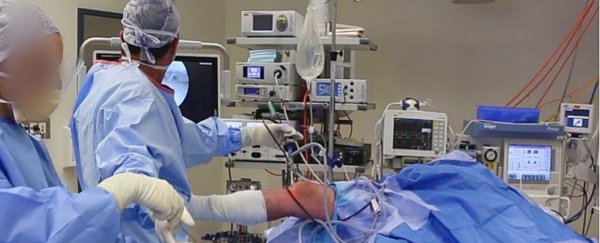How good are humans at performing manual surgery? Major surgical errors must be reported and there has been research into the attitudes of surgeons in how they report such errors.
But there is no requirement or legislation in place to report minor unintentional damage, and how that is even defined is a grey area.
Very little research exists into the frequency of unintentional surgical damage, the challenges that cause this damage, or understanding of the long-term effects.
We are developing semi-autonomous robotic tools to help surgeons, especially for knee surgery. It's estimated that around 4 million knee arthroscopies are performed each year worldwide.
In our recent study, some surgeons said they found that such knee procedures could be physically challenging and could cause unintentional damage to their patients.
But a majority said they would be prepared to use robotic tools if they could be shown to help in the surgery and reduce the risks of injury to patients.
Unintentional damage in surgery
Osteoarthritis is by far the leading cause of pain in joints, especially knees.
Following X-ray and MRI scans, the first line of minimally invasive diagnostic and treatment procedures is known as knee arthroscopy. It is a procedure in which a surgeon slides a camera and a range of instruments into the joint through small incisions.
This procedure is somewhat controversial as the evidence of its effectiveness for some patients has been questioned. But it is still one of the most common surgical procedures carried out in the world.
With our colleagues, we asked 93 surgeons in Australia with a range of experience how often they observed unintentional damage occurring during a knee arthroscopy. The survey was anonymous and the results were published earlier this year in the Journal of Orthopaedic Surgery.
Half the surgeons (49.5 percent) said unintentional damage to articular cartilage, which is the tissue that covers the end of your bones that make up your joints, occurred in at least one in ten procedures.
A third (34.4 percent) of them said the damage rate was at least one in five procedures. Incredibly, seven of the surgeons (7.5 percent) said such damage occurred in every procedure carried out.
Damage to cartilage is probably one of the causes of osteoarthritis and your body does not repair cartilage if damaged, which can then result in knee pain.
So patients who suffer unintentional cartilage damage during an arthroscopy have an additional risk of developing osteoarthritis. This is somewhat ironic, given that the motivation for many arthroscopic procedures is to try to treat osteoarthritis.
A pain for the surgeon
Knee arthroscopy is considered straightforward, and a skilled surgeon will make it look easy. But it is actually very difficult and requires considerable skill and experience.
During the procedure, the leg must be manipulated to create the space for the camera and the tools. This means that the surgeon has to continually lift and hold the leg, while at the same time hold the camera and the tools and operate by looking at the video on a screen.
We asked the surgeons whether they found knee arthroscopy to be physically challenging, and whether they had experienced pain themselves after performing this surgery.
Nearly 59 percent reported they found the procedure to be physically challenging, and more than a fifth (22.6 percent) said they had experienced physical pain afterwards. It is in the interests of patients that their surgeons remain in good health.
Robots to the rescue
So how can we reduce the risk of any unintentional damage during knee arthroscopy surgery and make the procedure less challenging for the surgeon?
At the moment there are no robotically assisted technologies used in knee arthroscopy. All the surgery is performed manually.
Our current research focuses on how robots can be used by surgeons to improve patient and surgeon safety, to reduce the need for future medical treatment, and to lower the costs of healthcare.
We are exploring how robots can be used to hold and move the leg during a knee arthroscopy, freeing the surgeon to focus on observing the interior of the knee.
We are also developing new types of flexible robots and tiny stereo cameras to replace the existing arthroscopes and which will feed into robotic vision systems to map the 3D structure of the knee.
These 3D knee maps will be used by other tool holding robots to avoid colliding with the cartilage.
Our aim is to give surgeons semi-autonomous robotic tools so they can concentrate on what they are best at: deciding what is wrong with the patient and how to treat it.
About a third (32.3 percent) of surgeons we surveyed said they were nervous about the introduction of any semi-autonomous arthroscopic systems.
But about three-quarters (76.3 percent) said they would use a robotic assist system if it improved the efficiency of the procedure, and 86 percent said they would use a robot if it decreased the rate of unintentional damage to cartilage.
Overall, 47.3 percent of the surgeons said they saw a future role for semi-autonomous arthroscopic systems.
All surgeons will tell you that surgery carries a risk. As a patient, you must balance the benefits of a given surgery against those risks.
![]() Future upgrades to their toolkit in the form of robotic manipulators, scopes and tools, will hopefully allow surgeons to reduce the risks for both the patients and themselves.
Future upgrades to their toolkit in the form of robotic manipulators, scopes and tools, will hopefully allow surgeons to reduce the risks for both the patients and themselves.
Anjali Jaiprakash, Advance Queensland Fellow, Medical Robotics, Queensland University of Technology; Jonathan Roberts, Professor in Robotics, Queensland University of Technology, and Ross Crawford, Professor of Orthopaedic Research, Queensland University of Technology.
This article was originally published by The Conversation. Read the original article.
Queensland University of Technology is a sponsor of ScienceAlert. Find out more about their research.
